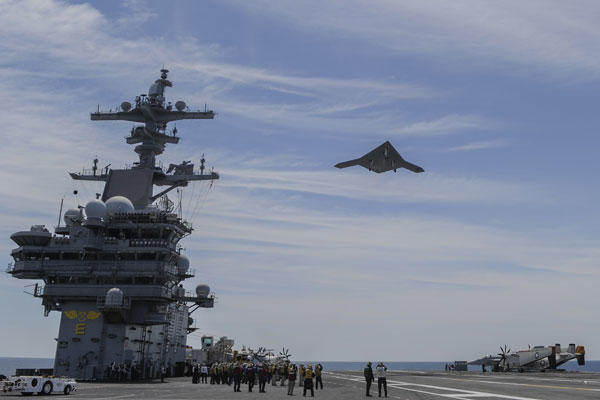The Navy plans to add weapons and precision strike mission sets to its aircraft carrier-based drone platform -- the Unmanned Carrier Launched Surveillance and Strike -- following support from Navy Secretary Ray Mabus.
Last month, members of Congress questioned whether the UCLASS was too focused on intelligence, surveillance and reconnaissance missions and lacking requirements to develop a precision strike capability.
Mabus has since responded to the letter and indicated support for the positions on UCLASS expressed by the lawmakers, Navy officials said.
"[Mabus] agreed that the UCLASS program was the next major step in naval aviation and that it had to be designed and developed as a key part of a carrier wing," said Cmdr. Tamara Lawrence, Mabus' spokesperson.
Questions have swirled around the scope of requirements and mission sets for the UCLASS as two members of Congress had expressed concern that the platform's requirements were too narrowly configured.
One source indicated there were ongoing discussions about the scope of UCLASS requirements at the Pentagon's Joint Requirements Oversight Council. Some had advocated for a more narrowly configured set of requirements for the UCLASS platform, sources said.
Congressman Randy Forbes, R-Va., chairman of the Subcommittee on Seapower and Projection Forces, and Congressman Mike McIntyre, D-N.C., the subcommittee's ranking member, sent a letter to Mabus asking that the aircraft be developed with requirements aimed at a broader mission set beyond ISR missions, saying they wanted additional emphasis on precision-strike missions.
"We believe the current path could limit the capability growth of the system in the future. We believe UCLASS should be designed to be an integral part of the [Carrier Air Wing] that can employ in the full-spectrum of the Navy's power-projection mission," the September letter states.
The letter's position centers on the importance of establishing broad requirements so that the platform can evolve over time as technologies mature. Advocates for a wider set of mission roles for the UCLASS argued that the core ISR function will not be lessened but increased even with the focus on precision strike.
Mabus agreed with this position and wants the UCLASS platform to be able to accommodate technological change as it emerges, Lawrence explained.
"We have to ensure that there is capability growth in our programs. The secretary feels that is key and central to our UCLASS strategy," Lawrence said.
The UCLASS will give the Navy a long-dwell, persistent ISR capability while forward deployed at sea and removes the need to get permission from various host countries to land, fly and operate the aircraft.
Precision strike capability will add to the range and versatility of missions the aircraft will be able to perform, Navy officials said.
Over the summer, the Navy awarded four contracts valued at $15 million for preliminary design review for the UCLASS to Boeing, General Atomics Aeronautical Systems, Lockheed Martin and Northrop Grumman.
Meanwhile, a draft request for proposal is expected to be released next month for industry to review, followed by a formal notice released during the second quarter of fiscal 2014. The Navy plans to down-select to a single UCLASS air vehicle in about a year, said Capt. Beau Duarte, who manages the Unmanned Carrier Aviation Program Office.
Emphasizing that unmanned systems are among Mabus' priorities, Lawrence said the secretary also agrees that the UCLASS should be an integral part of the carrier wing.
"When you put together a strike plan, your UCLASS will be discussed in the same vein that you talk about your fighter aircraft," Lawrence added.
























